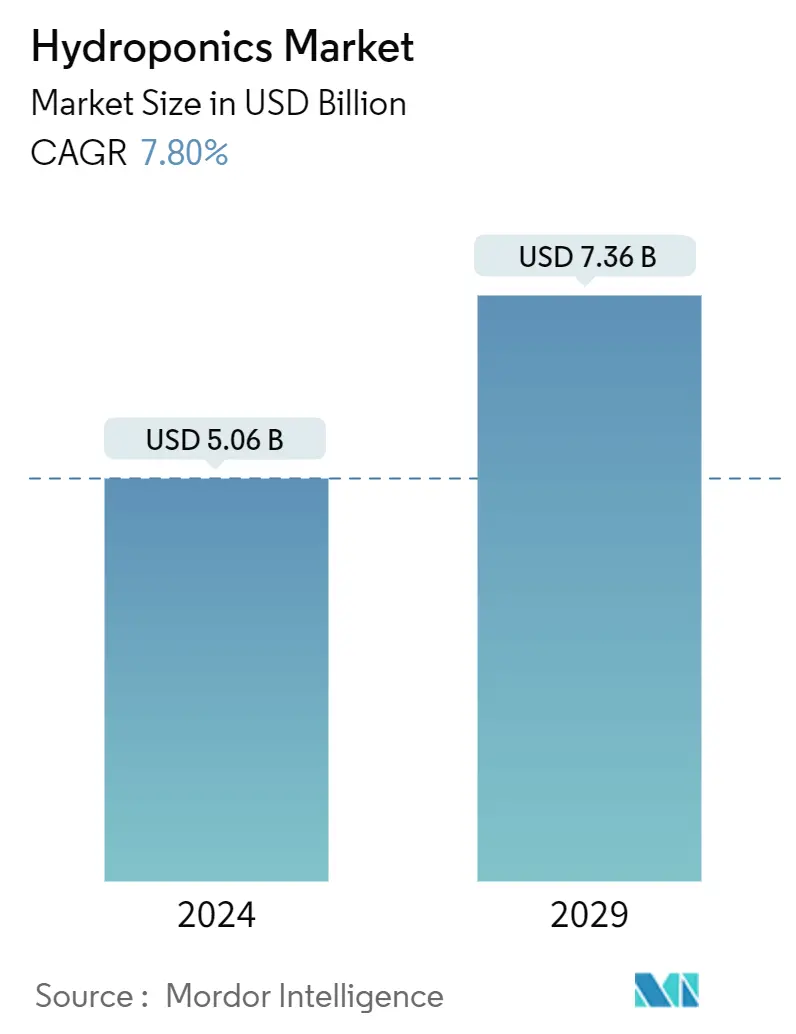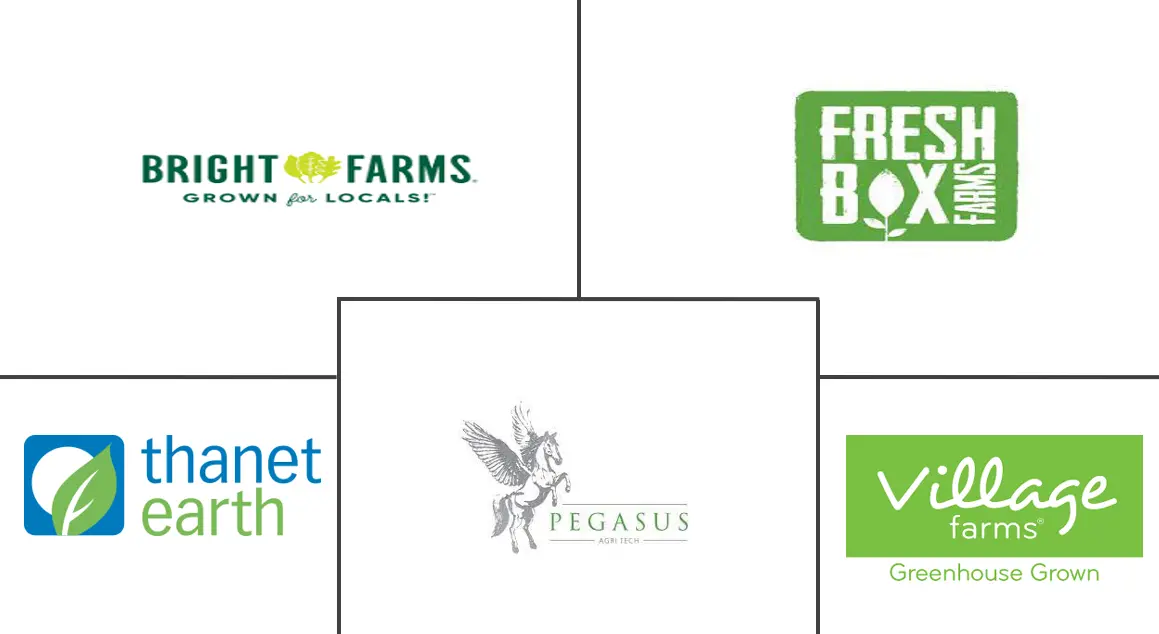Market Size of Hydroponics Industry

| Study Period | 2019 - 2029 |
| Market Size (2024) | USD 5.06 Billion |
| Market Size (2029) | USD 7.36 Billion |
| CAGR (2024 - 2029) | 7.80 % |
| Fastest Growing Market | Asia Pacific |
| Largest Market | North America |
Major Players
*Disclaimer: Major Players sorted in no particular order |
Hydroponics Market Analysis
The Hydroponics Market size is estimated at USD 5.06 billion in 2024, and is expected to reach USD 7.36 billion by 2029, growing at a CAGR of 7.80% during the forecast period (2024-2029).
- Hydroponic farming offers benefits beyond environmental protection, including higher crop yields than traditional open-field cultivation. Moreover, the rising health consciousness among consumers has spurred increased demand, driving the adoption of hydroponic production methods. Factors such as the growing global population, limited cultivable land availability, government incentives, and a rising demand for fresh, high-quality food contribute to the trend.
- The adoption of hydroponics has been particularly high in urban areas, where approximately 56% of the world's population resides, as the World Health Organization and the Population Council reported in 2023. The scarcity of land in urban settings has led to the adoption of innovative solutions such as hydroponics, which allow growers to optimize space for cultivating crops efficiently. Hydroponics offers a way to grow high-quality produce year-round, regardless of the season or weather conditions. This has led to a significant increase in the demand for hydroponic produce, particularly in urban areas with higher demand for fresh produce.
- According to the International Research Journal of Modernization in Engineering Technology (IRJETS), adopting hydroponics significantly conserves resources and boosts productivity. Soilless media saves 80% to 85% of irrigation water and 55% to 80% of fertilizer while increasing vegetable productivity by 100% to 150%. Hydroponics can save 85% to 90% of irrigation water in a nutrient solution system, reduce fertilizer use by 68% to 85%, and increase vegetable productivity by 200% to 250%.
- Additionally, hydroponics provides an effective food security solution to attain self-sufficiency in food, as the technology uses space efficiently and can be applied even by landless urban and rural people. For instance, Pure Food Technology, a startup based in the UAE specializing in sustainable agriculture and food technology, has developed an innovative hydroponic prototype. This prototype consumes 95% less water than traditional farming methods and delivers a crop yield 100 times higher. The breakthrough technology is projected to significantly reduce the UAE's USD 7.7 billion expenditure on fresh vegetable imports and contribute to the country's goal of achieving self-sufficiency in nutrient-rich plant-based foods.
- Moreover, hydroponics is an eco-friendly and profitable technology, particularly in North America, Europe, and Asia. Countries in these regions have received support from governments and non-governmental organizations due to hydroponics' positive impact on food security. For instance, Wucheng County in Dezhou, Shandong Province, China, has launched a program that allows a new generation of growers to apply their technical knowledge and skills to advance the regional horticulture industry. As part of this program, they have developed a hydroponic cabbage that matures in 20 days, allowing up to 15 harvests per year.
- Also, the increasing demand for food, driven by the projected population growth by 2050, has fueled the expansion of the hydroponics market. Moreover, as commercial hydroponics ventures achieve greater success and soil-based crop cultivation becomes more challenging, the hydroponics market is anticipated to experience rapid growth during the forecast period.
Hydroponics Industry Segmentation
Hydroponics involves the process of growing plants using mineral nutrient solutions in sand, gravel, or liquid without using soil. In simple words, hydroponic is a technique for growing plants without soil.
The hydroponics market is segmented by type (aggregate hydroponic system (closed system and open system) and liquid hydroponic system), crop type (tomato, lettuce and leafy vegetables, pepper, cucumber, microgreens, and other crop types), and geography (North America, Europe, Asia-Pacific, South America, and Middle East and Africa). The report offers the market sizes and forecast values (USD) for all the above segments.
| Type | ||||
| ||||
| Liquid Hydroponic System |
| Crop Type | |
| Tomato | |
| Lettuce and Leafy Vegetables | |
| Pepper | |
| Cucumber | |
| Microgreens | |
| Other Crop Types |
| Geography | |||||||||
| |||||||||
| |||||||||
| |||||||||
| |||||||||
|
Hydroponics Market Size Summary
The hydroponics market is poised for significant growth, driven by the increasing demand for sustainable and efficient farming methods. This innovative agricultural practice, which involves growing plants without soil, is gaining traction due to its ability to produce higher crop yields and conserve resources such as water and fertilizers. The rising health consciousness among consumers and the growing global population are further propelling the adoption of hydroponics, as it offers a solution to the challenges posed by limited arable land and the need for fresh, high-quality food. Urban areas, where space is at a premium, are particularly embracing hydroponics, allowing for year-round cultivation of produce regardless of seasonal or weather conditions. This trend is supported by government incentives and technological advancements, making hydroponics an attractive option for both urban and rural settings.
The market landscape is characterized by a diverse range of players, from large companies to smaller enterprises, all vying for a share in this burgeoning industry. Key regions such as North America, Europe, and Asia are witnessing robust support from governments and NGOs, recognizing the positive impact of hydroponics on food security and sustainability. The market is further bolstered by the increasing consumer demand for exotic vegetables and the growing popularity of hydroponically grown produce in various sectors, including hospitality and retail. As commercial hydroponics ventures continue to expand and innovate, the market is expected to experience rapid growth, with significant contributions from both established and emerging players. The focus on developing competitive hydroponic production systems will be crucial in meeting the rising demand and achieving self-sufficiency in food production.
Hydroponics Market Size - Table of Contents
-
1. MARKET DYNAMICS
-
1.1 Market Overview
-
1.2 Market Drivers
-
1.3 Market Restraints
-
1.4 Porter's Five Forces Analysis
-
1.4.1 Bargaining Power of Suppliers
-
1.4.2 Bargaining Power of Buyers
-
1.4.3 Threat of New Entrants
-
1.4.4 Threat from Substitutes
-
1.4.5 Intensity of Competitive Rivalry
-
-
-
2. MARKET SEGMENTATION
-
2.1 Type
-
2.1.1 Aggregate Hydroponic System
-
2.1.1.1 Closed System
-
2.1.1.2 Open System
-
-
2.1.2 Liquid Hydroponic System
-
-
2.2 Crop Type
-
2.2.1 Tomato
-
2.2.2 Lettuce and Leafy Vegetables
-
2.2.3 Pepper
-
2.2.4 Cucumber
-
2.2.5 Microgreens
-
2.2.6 Other Crop Types
-
-
2.3 Geography
-
2.3.1 North America
-
2.3.1.1 United States
-
2.3.1.2 Canada
-
2.3.1.3 Mexico
-
2.3.1.4 Rest of North America
-
-
2.3.2 Europe
-
2.3.2.1 Germany
-
2.3.2.2 United Kingdom
-
2.3.2.3 France
-
2.3.2.4 Spain
-
2.3.2.5 Italy
-
2.3.2.6 Netherlands
-
2.3.2.7 Rest of Europe
-
-
2.3.3 Asia-Pacific
-
2.3.3.1 China
-
2.3.3.2 Japan
-
2.3.3.3 India
-
2.3.3.4 Australia
-
2.3.3.5 Rest of Asia-Pacific
-
-
2.3.4 South America
-
2.3.4.1 Brazil
-
2.3.4.2 Argentina
-
2.3.4.3 Rest of South America
-
-
2.3.5 Middle East and Africa
-
2.3.5.1 Saudi Arabia
-
2.3.5.2 United Arab Emirates
-
2.3.5.3 South Africa
-
2.3.5.4 Rest of Middle East and Africa
-
-
-
Hydroponics Market Size FAQs
How big is the Hydroponics Market?
The Hydroponics Market size is expected to reach USD 5.06 billion in 2024 and grow at a CAGR of 7.80% to reach USD 7.36 billion by 2029.
What is the current Hydroponics Market size?
In 2024, the Hydroponics Market size is expected to reach USD 5.06 billion.

